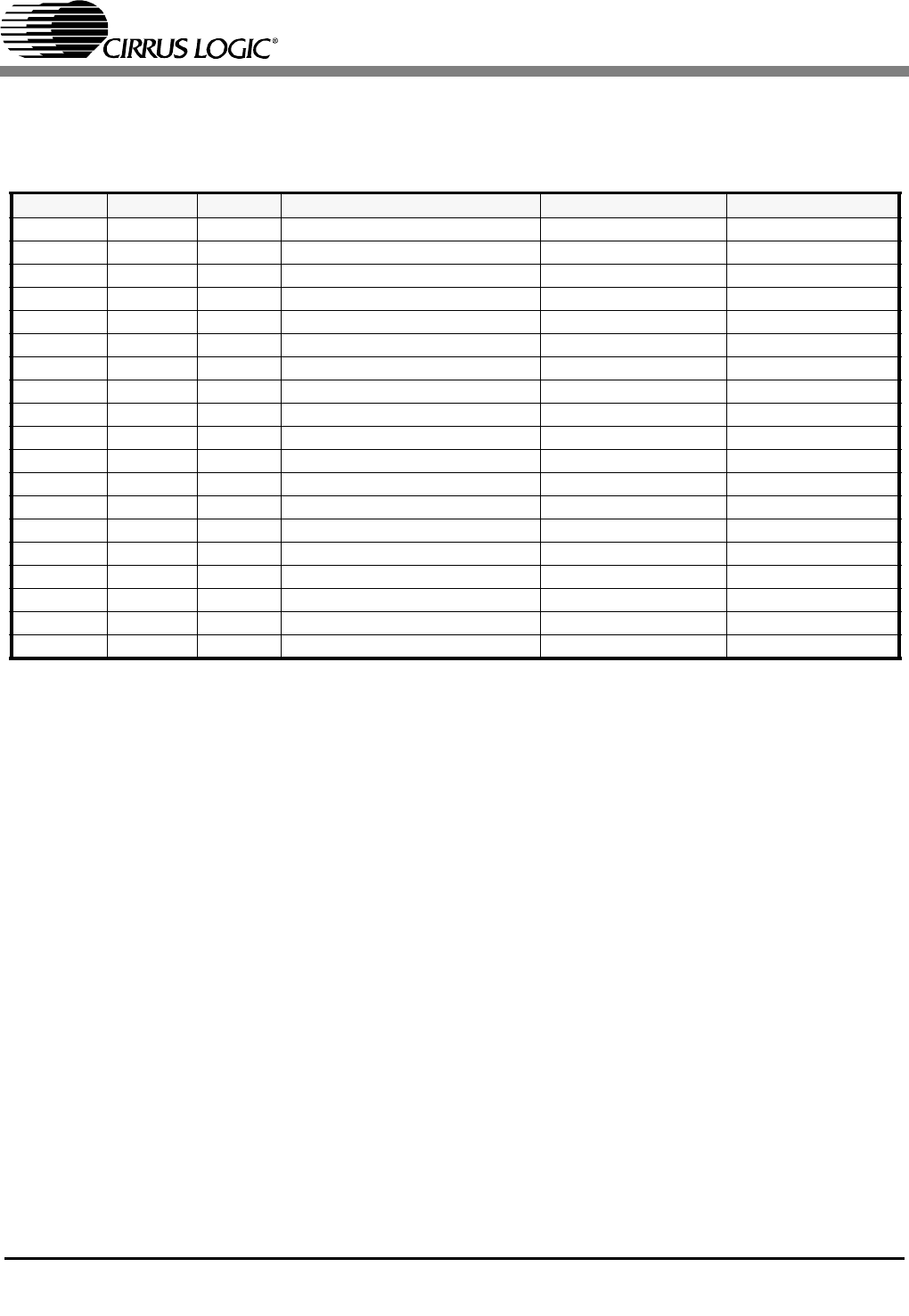User Manual
Table Of Contents
- Features
- Description
- 1. Pin Out - 144-Pin LQFP Package
- 2. Pin Out - 160-Ball FBGA Package
- 3. Pin Descriptions
- 4. operation
- 5. Power-up
- 6. Master Clock
- 7. G.772 Monitoring
- 8. Building Integrated Timing Systems (BITS) Clock Mode
- 9. Transmitter
- 10. Receiver
- 11. Jitter Attenuator
- 12. Operational Summary
- 13. Host Mode
- 14. Register Descriptions
- 14.1 Revision/IDcode Register (00h)
- 14.2 Analog Loopback Register (01h)
- 14.3 Remote Loopback Register (02h)
- 14.4 TAOS Enable Register (03h)
- 14.5 LOS Status Register (04h)
- 14.6 DFM Status Register (05h)
- 14.7 LOS Interrupt Enable Register (06h)
- 14.8 DFM Interrupt Enable Register (07h)
- 14.9 LOS Interrupt Status Register (08h)
- 14.10 DFM Interrupt Status Register (09h)
- 14.11 Software Reset Register (0Ah)
- 14.12 Performance Monitor Register (0Bh)
- 14.13 Digital Loopback Reset Register (0Ch)
- 14.14 LOS/AIS Mode Enable Register (0Dh)
- 14.15 Automatic TAOS Register (0Eh)
- 14.16 Global Control Register (0Fh)
- 14.17 Line Length Channel ID Register (10h)
- 14.18 Line Length Data Register (11h)
- 14.19 Output Disable Register (12h)
- 14.20 AIS Status Register (13h)
- 14.21 AIS Interrupt Enable Register (14h)
- 14.22 AIS Interrupt Status Register (15h)
- 14.23 AWG Broadcast Register (16h)
- 14.24 AWG Phase Address Register (17h)
- 14.25 AWG Phase Data Register (18h)
- 14.26 AWG Enable Register (19h)
- 14.27 Reserved Register (1Ah)
- 14.28 Reserved Register (1Bh)
- 14.29 Reserved Register (1Ch)
- 14.30 Reserved Register (1Dh)
- 14.31 Bits Clock Enable Register (1Eh)
- 14.32 Reserved Register (1Fh)
- 14.33 Status Registers
- 15. Arbitrary Waveform Generator
- 16. JTAG Support
- 17. Boundary Scan Register (BSR)
- 18. Applications
- 19. Characteristics and specifications
- 19.1 Absolute Maximum Ratings
- 19.2 Recommended Operating Conditions
- 19.3 Digital Characteristics
- 19.4 Transmitter Analog Characteristics
- 19.5 Receiver Analog Characteristics
- 19.6 Jitter Attenuator Characteristics
- 19.7 Master Clock Switching Characteristics
- 19.8 Transmit Switching Characteristics
- 19.9 Receive Switching Characteristics
- 19.10 Switching Characteristics - Serial Port
- 19.11 Switching Characteristics - Parallel Port (Multiplexed Mode)
- 19.12 Switching Characteristics- Parallel Port (Non-Multiplexed Mode)
- 19.13 Switching Characteristics - JTAG
- 20. Compliant Recommendations and specifications
- 21. 160-Ball FBGA package dimensions
- 22. 144-Pin LQFP Package dimensions

CS61880
DS450PP3 29
12. OPERATIONAL SUMMARY
A brief summary of the CS61880 operations in hardware and host mode is provided in Table 8.
12.1 Loopbacks
The CS61880 provides three loopback modes for
each port. Analog Loopback connects the transmit
signal on TTIP and TRING to RTIP and RRING.
Digital Loopback Connects the output of the En-
coder to the input of the Decoder (through the Jitter
Attenuator if enabled). Remote Loopback connects
the output of the Clock and Data Recovery block to
the input of the Pulse Shaper block. (Refer to de-
tailed descriptions below.) In hardware mode, the
LOOP[7:0] pins are used to activate Analog or Re-
mote loopback for each channel. In host mode, the
Analog, Digital and Remote Loopback registers are
used to enable these functions (Refer to the Analog
Loopback Register (01h) (See Section 14.2 on
page 35), Remote Loopback Register (02h) (See
Section 14.3 on page 35), and Digital Loopback
Reset Register (0Ch) (See Section 14.13 on
page 36).
12.2 Analog Loopback
In Analog Loopback, the output of the
TTIP/TRING driver is internally connected to the
input of the RTIP/RRING receiver so that the data
on TPOS/TNEG and TCLK appears on the
RPOS/RNEG and RCLK outputs. In this mode the
RTIP and RRING inputs are ignored. Refer to
Figure 7 on page 30. In hardware mode, Analog
Loopback is selected by driving LOOP[7:0] high.
In host mode, Analog Loopback is selected for a
given channel using the appropriate bit in the Ana-
log Loopback Register (01h) (See Section 14.2 on
page 35).
NOTE: The simultaneous selection of Analog and
Remote loopback modes is not valid. A TAOS
request overrides the data on TPOS and TNEG
during Analog Loopback. Refer to Figure 8 on
page 30.
Table 8. Operational Summary
MCLK TCLK LOOP Receive Mode Transmit Mode Loopback
Active Active Open RCLK/Data Recovery Unipolar/Bipolar Disabled
Active Active L RCLK/Data Recovery Unipolar/Bipolar Remote Loopback
Active Active H RCLK/Data Recovery Unipolar/Bipolar Analog Loopback
Active L X RCLK/Data Recovery Power Down Disabled
Active H Open RCLK/Data Recovery TAOS Disabled
Active H L RCLK/Data Recovery Unipolar/Bipolar Remote Loopback
Active H H RCLK/Data Recovery TAOS Analog Loopback
L Active X Power Down Unipolar/Bipolar Disabled
L H X Power Down RZ Data Disabled
L L X Power Down Power Down Disabled
H Active Open Data Recovery Unipolar/Bipolar Disabled
H Active L Data Recovery RZ Data Remote Loopback
H Active H Data Recovery Unipolar/Bipolar Analog Loopback
H L Open Data Recovery Power Down Disabled
H L L Data Recovery RZ Data Remote Loopback
H L H Data Recovery Power Down Disabled
H H Open Data Recovery RZ Data Disabled
H H L Data Recovery RZ Data Remote Loopback
H H H Data Recovery RZ Data Analog Loopback










